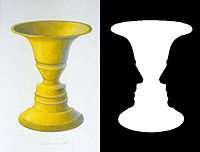


Above is Rubins Vase which is
a classic example of Negative Space.
In art, negative space is the area around and between the subject of an image. Negative space around the subject forms the mood and visual interpretation of art. Three elementary examples of negative space are as follows:
One of the most well known examples of a negative space study is Rubin's vase which is an optical illusion that visually toggles the silhouettes of two profile faces that surround a vase. On the yellow vase, the negative space reveals a profile figure silhouette that causes the eye to read one profile face on one side of the vase and then the eye reads the profile face on the other side and rarely can the eye send a signal to the brain to read both profile faces at the same time that surrounds the yellow vase. The same vase shown on the black and white portion of the image is a good example of figure-ground reversal effect. The eye can read both profile faces at once and toggle back to the white image of the vase. There are instances where elements in an image distract from the subject. Photographs are examples that can have element distraction. Element distractions might be on a different plane or the same plane within a composition and they are not considered negative space. Snapshots often show various elements scattered throughout an image yet these elements are not negative space. These objects are basic elements within or around the subject matter. The creative use of negative and positive space is what differentiates a snapshot from an artistic photograph. When an artist is designing original art work, the interplay of negative space and positive space is used to lead the viewer in and around the subject matter within the composition. This is why knowing how to design with negative and positive space is so important when creating art work. The use of equal negative space, as a balance to positive space, in a composition is considered to be good design. Learning to use the negative space (background) around the positive space (subject) gives the eyes a place to rest. The negative space area is often overlooked and causes a weak link in an overall composition when left unconsidered. In summary, negative space surrounding any art, whether it is within a three dimensional room or a flat white canvas or a three dimensional object visually affects the overall perception of art and is a design element that can be used as a neutral area or draw attention to the main subject. Now its Your Turn to Experiment with Negative Space |
|
Lesson One: Using a profile of a person or animal recreate your own version of the (above illustration) black and white version of the “Rubin’s” vase experiment on a white surface. Place the subject on a white sheet of paper and use texture, patterns etc. to fill in the negative space around the subject. Notice how the subject responds to each solution that you try. There isn't a right or wrong design solution, however, there will be layouts that feel stronger or more balanced due to the use of negative and positive space within the composition. |
Lesson Two: Choose a simple subject like an animal or person or object from a magazine or newspaper or use clip art. Use the yellow example on “Rubin’s Vase” as a guide. Place the subject on a white sheet of paper and use texture, patterns etc. to fill in the negative space around the subject. Notice how the subject responds to each solution that you try. There isn't a right or wrong design solution, however, there will be layouts that feel stronger or more balanced due to the use of negative and positive space within the composition. |
Please subscribe to our mailing list.